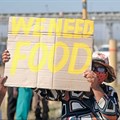Nelson Mandela said that "Freedom is meaningless if people cannot put food in their stomachs, if they can have no shelter, if illiteracy and disease continue to dog them." Because of gross inequality, far too many South Africans live on the periphery of the economic and social mainstream, and struggle to access safe, affordable and nutritious food.

Andy Du Plessis, managing director of FoodForward SA. Source: Supplied
Section 27 (1) of our Constitution states that everyone has the right to have access to sufficient food and water. This obligation is extended in section 27 (2), whereby the state must take reasonable legislative and other measures, within its available resources, to achieve the progressive realisation of each of these rights.
While government is not obliged to provide food to people, it has a crucial role to play in creating an enabling environment for people to be able to access safe, affordable and nutritious food. Since the right to food is directly linked to the right to life and the right to dignity, an exclusion of these rights is simply unjust, and a curtailment of people’s freedom.
Food justice in SA - a pipe dream?
Food justice commonly refers to universal access to safe, nutritious, affordable, and culturally acceptable food. Sadly, this is not the case in South Africa, given that around 30 million people are estimated to be moderately or severely food insecure. According to the 2020 SA Health Review, 27,4% of children aged between 0 to 5 years in South Africa suffer from stunting – a form of severe malnutrition that causes impaired growth, increased vulnerability to infections, and inadequate psychosocial development.
The report also indicates that 33% of our children live below the food poverty line, and maternal malnutrition is increasing. The UCT Child Gauge 2020 Report describes the state of child malnutrition as “a form of slow violence”.
Andy Du Plessis 15 Jun 2021 In spite of the fact that South Africa has achieved freedom and democracy 27 years ago, widespread inequality continues to imprison poor people and perpetuate multi-generational poverty because their choices are limited. As a consequence, vulnerable people have limited opportunities, low levels of education, are more susceptible to illnesses and diseases, and more exposed to unscrupulous people and systems that can easily take advantage of their disposition, such as gangsterism, drug peddling, prostitution, and opportunistic and violent crime.
The Bureau for Food and Agriculture Policy’s (BFAP) Baseline Agricultural Outlook for 2021 – 2030 released in September 2021 states that the agricultural sector grew by 13% in 2020, yielding a trade surplus of more than R60bn. However, the report notes that “Unfortunately, despite the sector’s successful contribution to food security through the availability of food, the stark reality is that approximately half of the South African population cannot afford a basic healthy diet.”
So, if we have sufficient food in South Africa, why are we seeing such high incidences of child malnutrition and food insecurity at the household level? Gross inequality and a fragmented food system are the main drivers of this social injustice. According to Statistics South Africa, because South Africa is one of the most unequal countries in the world, “the bottom 60% of households are more dependent on social grants than on income from the labour market.”
Given the relatively low economic growth prospects for South Africa over the next 3 to 5 years, combined with rising unemployment, we are not likely to see inequality meaningfully reduced in the foreseeable future.
Food system transformation: a long-term endeavour
There are discussions among various sectors around the transformation of our food system, to allow for greater inclusivity and access. However, our food system is so vast and so complex from farm to fork, that any form of progress firstly requires a willingness towards transformation, transparency throughout the food supply chain, an openness towards a more just food system, and an inclination towards multi-stakeholder collaboration.
While such a process is absolutely necessary, it is a more long-term endeavour, and I am not optimistic that we are likely to see the desired transformation in the short to medium term.
The United Nations State of Food and Nutrition Security in the World 2021 Report states that South Africa is not likely to meet the 2030 Sustainable Development Goal (SDG) 2 of Zero Hunger, mostly because we were not on track prior to the pandemic, and partly because the pandemic has made this goal significantly more challenging.
In terms of South Africa’s scorecard on food security and nutrition, the report states that:
• About 3,8 million people are estimated to be undernourished
• About 26,3 million people are estimated to be moderately or severely food insecure
• About 1,3 million children under 5 are estimated to be stunted
Camilla Adelle 13 Oct 2021 Dr Lawrence Haddad, executive director of the Global Alliance for Improved Nutrition says that malnutrition systematically destroys a child. It damages their chances of survival, their cognitive development, their immune system, their bone and muscle structure, and their livelihood prospects.
The current state of affairs in South Africa is inhumane and unjust. If we are to see any real progress towards food justice in our country, we must focus our attention on the long-term well-being of our most vulnerable population groups – children, pregnant and nursing mothers, and child-headed households.
We need appropriate, cost-effective and scalable interventions that will move the needle rapidly. We also need preventative interventions, to ensure that food insecurity is addressed at the household level. Food justice must be realised for all our people to be truly free.

























